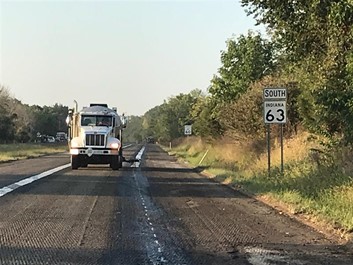Studies have shown that longitudinal joints in pavements are often the weakest areas of a road. Typically the joints are low in density, high in voids and thus are highly permeable. These areas become conduits to air and water infiltration which leads to damage and premature pavement failure.(1)
Many states have specified and instituted a new method of longitudinal joint construction. This method is a materials approach and is referred to as VRAM(2), a Void Reducing Asphalt Membrane. Applying VRAM at the time of construction helps fill the pavement voids, thus reducing the permeability in this most critical area.
In early September 2021, VRAM is shown here being sprayed on State Road 63 in Vigo County, Indiana by Illiana Construction on a Milestone South project for INDOT. In the picture below you will note that VRAM is being sprayed on the right shoulder joint southbound with a northbound application.
How VRAM Works?
Prior to paving, VRAM material is sprayed on an 18” wide location directly under the area where the longitudinal joint will be located. (3) When the HMA is placed and compacted over VRAM, the material migrates upward into the fresh pavement. It fills voids to help ensure the joint is less permeable.
Asphalt Materials, a midwestern based company that has been involved in the asphalt business since 1956, supplies an industry leading VRAM named J-Band®.
Here we are showing VRAM on the southbound shoulder joint of the pavement.
———
Notes:
(1) The density and air void content of asphalt mixtures affect the durability and performance of asphalt pavements. Pavement longitudinal joints typically have a lower density than the mat because they receive less compaction than the center section of the mat for various reasons. The higher air void percentages resulting from lower densities can lead to high permeability and allow water infiltration, which in turn can cause moisture-induced damage and decrease base and subbase support to the pavement, reducing pavement life. Void-reducing asphalt membrane (VRAM) has been used at the longitudinal joints of asphalt pavements to achieve higher densities and prevent moisture infiltration, thereby reducing deterioration at the longitudinal joints. VRAM is applied before the hot-mix asphalt (HMA) layer is placed and migrates into the HMA to fill 50% to 70% of the air voids. (Iowa State University Study for Minnesota Department of Transportation, DEC. 2020)
(2) Editor’s Notes: VRAM, Void Reducing Asphalt Membrane is referred to in Illinois as LJS, Longitudinal Joint Sealant.
(3) Depending on the situation VRAM can be sprayed at different width’s. This article notes 18” which is a typical application width for centerline applications.
J-Band® is a product of Asphalt Materials, Inc. and created in the labs of Heritage Research Group.



